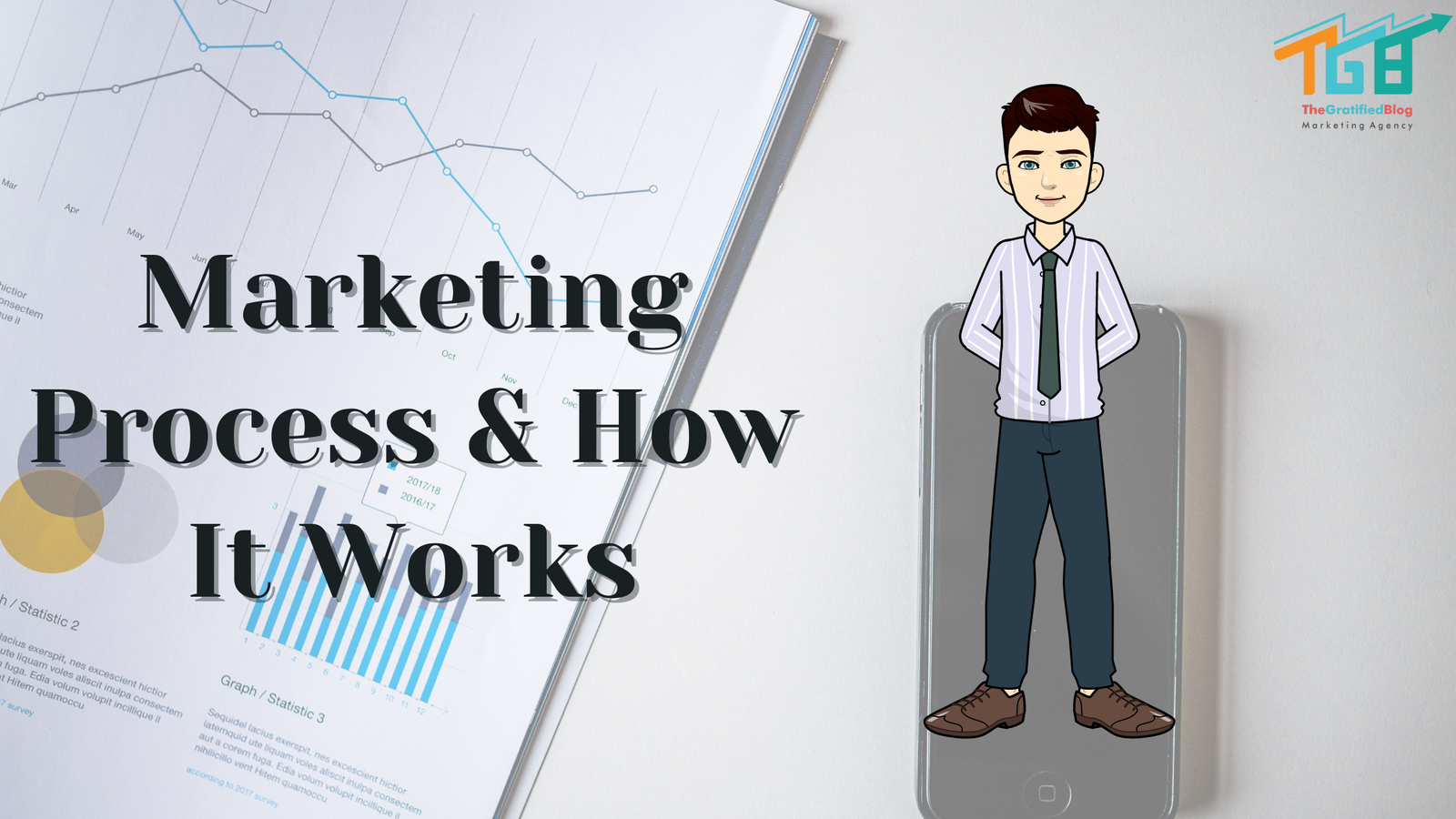
In today’s competitive business landscape, a well-defined marketing process is crucial for companies to thrive and succeed. Whether you are a small business owner or part of a marketing team, understanding the fundamental steps of the marketing process can provide valuable insights and guide your efforts toward achieving your goals.
In this blog post, we will delve into the five critical steps of the marketing process and explore how each step contributes to the overall success of your marketing initiatives. From market research to plan execution, product delivery, and promotion, we will take you on a journey through the intricacies of the marketing process.
So, Let’s Begin;
What Is The Marketing Process?
The marketing process is a comprehensive and sequential series of actions undertaken by the marketing team to plan, develop, and deliver products or services that satisfy customer needs.

It is a methodical approach encompassing various activities to achieve customer satisfaction and successful outcomes. Understanding and being familiar with the steps involved in the marketing process is essential for business owners. It enables them to gain insights into how marketing functions and empowers them to make informed decisions regarding their marketing strategies.
By grasping the workings of marketing process management, businesses can effectively steer their marketing efforts in the right direction, ensuring continued progress and better alignment with customer expectations.
Let’s see how this process starts with the company and ends with customer satisfaction. Let’s dive into the primary steps involved in the company’s marketing process.
Five Key Steps In The Marketing Process
The five key steps that guide businesses in effectively promoting their products or services are as follows:
- Identification of Customer Needs.
- Develop a primary strategy.
- Decision making.
- Plan execution.
- Final result and product delivery.
Step 1) Identification of Customer Needs
The first step in the marketing process is to identify and understand the needs and wants of your target customers. This requires comprehensive market research and analysis to gain insights into customer preferences, behaviors, and pain points. Here are some critical aspects of this step:
- Market Research: Conduct thorough research to gather data on your target market. This includes demographics, psychographics, buying habits, and preferences. Use surveys, focus groups, interviews, and other research methods to gather relevant information.
- Customer Segmentation: Analyze the data collected to segment your customers into distinct groups based on their shared characteristics and needs. This helps you tailor your marketing efforts and messages to specific customer segments.
- Customer Profiling: Create detailed profiles of your target customers, including their demographics, interests, motivations, challenges, and aspirations. This helps you understand their needs deeper and develop more effective marketing strategies.
- Competitive Analysis: Assess your competitors’ offerings to understand how they address customer needs. Identify gaps or areas where you can differentiate your product or service to effectively meet customer needs.
A range of valuable tools exists to streamline the understanding of customer needs. Among these tools are Tableau, SurveyMonkey, Loop11, Ubersuggest, and numerous others.
The information you acquire during this research will be the base foundation data. It will guide you to build a marketing strategy and a marketing campaign.
Step 2) Develop A Basic Strategy And Plan
Once you have collected all the information you need, you can move further with the marketing process, and you can start by creating an intrinsic marketing strategy like:
Marketing Goals
Marketing goals are formulated based on a business’s specific objectives through marketing campaigns. As each business and its products or services are unique, it is crucial to establish clear goals to guide the planning process. Without a well-defined goal, strategic planning efforts may yield unsatisfactory outcomes.
Marketing Strategy
Once you set a clear goal for marketing, it’s time to build the strategy around it. If you have an online business, then this strategy must include the following:
- digital marketing
- content marketing
- social media marketing
- offline marketing like banners
- ads in newspapers
- Using different marketing channels, etc.
Step 3) Decision-Making
When developing a marketing plan aligned with your precise goals and strategy, it is crucial to make informed decisions. During this process, it is essential to consider the following points to create an effective and well-rounded plan.

- Overall Marketing Budget: The marketing budget refers to the allocated funds for all marketing activities and initiatives. Determining a realistic and appropriate budget that considers the desired outcomes, market competition, and available resources is essential. Careful consideration should ensure the budget is sufficient to support the planned marketing efforts and achieve the set goals.
- Product Specifications: Product specifications outline the product’s features, characteristics, and functionalities. This includes size, color, materials, technical specifications, and unique selling points. Clearly defining the product specifications is crucial as it ensures consistency, helps target the right audience, and enables effective communication of the product’s value to potential customers.
- Product Development Changes in the Future: Anticipating and planning for potential product development changes is essential for long-term success. This involves considering factors such as evolving market trends, customer feedback, technological advancements, and competitive landscape. By proactively planning for future product development changes, businesses can stay relevant, meet evolving customer needs, and maintain a competitive edge in the market.
- Product Promotion Channels: Product promotion channels are the various platforms and mediums through which marketing messages and promotional activities are delivered to the target audience. Examples include online channels like social media, search engine advertising, email marketing, and offline channels like print media, events, and direct mail. It is essential to carefully select the most effective promotion channels that align with the target audience’s preferences and reach them effectively.
- Deadline for Product Launch: Setting a deadline for a product launch is crucial for effective planning and execution. It helps in coordinating various marketing activities, aligning resources, and creating a sense of urgency. By having a clear deadline, businesses can ensure that all necessary tasks and preparations are completed in a timely manner, allowing for a successful and impactful product launch.
When you think and cover every point listed above while creating a plan, you will exactly get to know what product you are marketing and the actions you need to take to make a successful campaign.
Step 4) Plan Execution
Once the marketing plan is in place, the next step is to execute the plan effectively. This involves implementing the planned marketing activities and strategies to achieve the desired goals. Here are key aspects of the plan execution step:
- Task Assignment: Assign specific tasks and responsibilities to the members of the marketing team or relevant stakeholders involved in the execution process. Clearly communicate the objectives, timelines, and expectations to ensure everyone is aligned and aware of their roles.
- Implementation of Marketing Tactics: Put the planned marketing tactics into action. This may include launching advertising campaigns, creating and distributing content, optimizing online presence, conducting events or promotions, and managing public relations. Each tactic should be executed in a coordinated and timely manner.
- Monitoring and Tracking: Continuously monitor the progress and performance of the executed marketing activities. Track key metrics and indicators to assess their effectiveness in reaching the target audience, generating leads, driving conversions, and achieving the desired outcomes. Make adjustments or optimizations as needed based on the insights gained from monitoring.
- Collaboration and Communication: Foster collaboration and open communication among team members and stakeholders involved in the execution process. Regularly update and share progress, discuss challenges or opportunities, and seek feedback or input to ensure a coordinated effort and make informed decisions throughout the execution phase.
- Evaluation and Review: Once the initial execution is complete, conduct a comprehensive evaluation and review of the outcomes and results. Analyze the effectiveness of the executed plan, measure against the set goals and objectives, and identify areas of improvement or refinement for future marketing initiatives.
Step 5) Product Delivery and Promotion
After the marketing plan has been executed, the next step is to focus on product delivery and promotion. This step involves ensuring that the product or service reaches the target audience effectively and that promotional efforts are carried out to maximize its visibility and appeal. Here are key aspects of the product delivery and promotion step:
- Distribution Channels: Determine the most appropriate distribution channels to reach your target audience. This could include direct sales, retail partnerships, e-commerce platforms, or various channels. Ensure the product is available and easily accessible to customers through these channels.
- Logistics and Fulfillment: Pay attention to logistics and fulfillment processes to ensure smooth product delivery to customers. This involves managing inventory, order processing, shipping, and customer support. Provide customers with a seamless and efficient experience to enhance their satisfaction and encourage repeat purchases.
- Promotional Campaigns: Develop and implement promotional campaigns to create awareness and generate interest in the product. This can include marketing tactics such as advertising, public relations, social media marketing, influencer partnerships, content marketing, and email marketing. Tailor the promotional activities to resonate with your target audience and effectively communicate the product’s unique value proposition.
- Customer Engagement: Engage with customers throughout the product delivery and promotion phase. This can be done through personalized communications, providing exceptional customer service, and soliciting feedback and reviews. Actively listen to customer needs and promptly address concerns or inquiries to foster customer loyalty and positive word-of-mouth.
- Performance Measurement: Continuously monitor and measure the performance of product delivery and promotional efforts. Track key metrics such as sales, customer acquisition, customer satisfaction, brand awareness, and ROI. Use this data to evaluate the effectiveness of the strategies employed and identify areas for improvement in future marketing initiatives.
FAQs On the Marketing Process
Q: Is the marketing process a one-time activity?
A: No, the marketing process is not a one-time activity. It is an ongoing and iterative process that requires continuous evaluation, adaptation, and refinement.
Q2: Can the marketing process be customized for different industries?
A: The marketing process can be customized to suit different industries’ specific needs and dynamics.
Conclusion
By recognizing the importance of the marketing process and dedicating resources towards its implementation, businesses can significantly enhance their chances of achieving success and maintaining a competitive edge.








No Comments